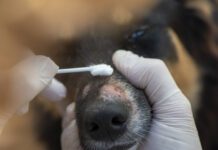Difficult to diagnose, yet easy to treat, sarcoptic mange is a miserably itchy, uncomfortable disease
Canine scabies, also known as sarcoptic mange, is a dreadfully itchy skin disease that affects an estimated 2% to 4% of the canine population. Courtesy of the Sarcoptes scabiei var canis mite, the condition is highly contagious and incredibly uncomfortable. Tiffany Tapp DVM, DACVD, of East Greenwich, Rhode Island, describes untreated scabies as “a painful, relentless, progressive condition.”
Though perhaps not as common today because of advancements in flea and tick preventives (some of which control for the mange mite), canine scabies should be on the radar for those of us who use a flea preventive that doesn’t control for mange mites, or those of us who are forgetful about administering preventive regularly to their dogs.
HOW SARCOPTIC MANGE IN DOGS SPREADS
The mite has a host preference for canids, including dogs, with fox and coyote serving as significant reservoirs. Practicing in New England, Dr. Tapp suspects that some of her patients contract the disease from wildlife.
If an infected fox sniffs around garbage bins or decking, for example, you may now have mites in your environment. Or your dog sticks his head in a hole that turns out to be a coyote or fox den, voilà, your dog can contract scabies. Then, when she scratches herself, mites drop off into her environment. And if she’s spending time in a place frequented by other dogs, i.e., veterinary clinics, groomers, dog parks, daycare, etc., your dog potentially becomes a Super Spreader, passing on her mites to other dogs she encounters.
Mite survivability off-host is typically only a few days, though they are infective in the environment for about 36 hours.
SCRATCH THAT ITCH – WHERE ARE MITES FOUND ON A DOG?
Once on board, mites tunnel into the dog’s skin, producing an intense itch. The mites are typically found on areas where there is less hair, such as ear flaps/margins of the ears, lateral elbows, hocks, and the ventrum (belly). Lesions, crusting, hair loss, and a thick crust along the pinnae (ear flap) soon develop.
The itch caused by the bite of the scabies mite differs in intensity from even seriously flea-allergic dogs. Dr. Tapp says, “In the exam room, for example, it’s non-stop scratching – a 10 on the pruritus (itch) scale.”
WHAT DOES SCABIES LOOK LIKE ON A DOG?
Dr. Tapp says she can prove that it’s mange via skin scraping only about once in every 10 times. “The mites are hard to find on a skin scrape, because they are notorious tunnelers; plus, it doesn’t take many to make a dog itchy, so they’re easy to miss. A negative skin scraping doesn’t necessarily mean anything.”
A vet might suggest a polymerase chain reaction (PCR) test, in which a sample is analyzed to see if it contains genetic material from Sarcoptes scabiei – but, says Dr. Tapp, these tests are not always accurate.
That said, mange is always on her differential for an itchy dog, particularly if the dog is super itchy and doesn’t have a history of severe pruritus. Additional clues that lead her to consider a diagnosis of sarcoptic mange include:
Pinnal-pedal scratch reflex. The pinnal-pedal scratch reflex is assessed by vigorously rubbing the tip of one of the dog’s earflaps against the base of her ear for five seconds. The test is considered positive if the dog’s hind leg makes scratching motions. Dr. Tapp says, “A positive reaction should give the vet pause to consider scabies on the differential, but not all dogs with a positive reflex have scabies.”
Itchy human. Mites can cause temporary itching and irritation on our arms, neck, and waistline. Although this mite cannot reproduce on people and dies on its own fairly quickly, if the animal remains untreated, the humans in the household are fair game.
History. A variety of treatments that failed to address the itching, including bathing, or an initial good response to steroid therapy followed by recurrent pruritus are a couple of flags. Usually by the time a dog gets to Dr. Tapp and she reads the dog’s history, she already has a good idea of whether the dog should be isolated because it may have the highly contagious disease.
Pattern. Where is the itching, crusting and hair loss?
• Ears, elbows, hocks, ventrum: Mange suspected.
• Rump, tail, back of legs: Flea allergy likely.
• Paws, front of elbow, face and groin (places that touch the ground where the dog can absorb pollens): Atopic dermatitis.
• “Ears & rears”: Food allergy, although this is a great one for mimicking flea allergy.
Demodectic mange is caused by Demodex canis, a different parasitic mite than the one that causes sarcoptic mange or “scabies.” Demodectic mange, sometimes just called “demodex,” is the most common form of mange in dogs – but not because it’s infectious and transmissible like the scabies mite. As it turns out, most dogs (and humans!) have some species of Demodex mites living on their skin all the time! But only some dogs develop hair loss and itching from an overgrowth of these mites, due to a depressed immune system, which fails to take appropriate action to control the mites. Poor nutrition, stress, exposure to the elements, and a lack of clean places to live all contribute to the immune-system depression that can lead to an overgrowth of Demodex. Fortunately, today’s isoxaline-class medications readily treat these infections, quickly stopping the itching and allowing the dog’s hair to regrow.
SARCOPTIC MANGE TREATMENT FOR DOGS
Since a negative scraping is insufficient to rule out scabies, a “may be mange” medication trial is often implemented. The dog is treated for sarcoptic mange and observed for resolution of symptoms over the course of a few weeks. Treatment is simple and typically successful; treating with a trial course of medication offers a quick rule in/rule out.
A variety of treatment options are available, including the use of some routine flea/tick preventives. Used regularly, some – though not all – preventives keep mange from ever taking hold on a dog, which is a likely reason why there are not more cases.
For a long time, off-label, multiple doses of ivermectin, administered orally or via injection, was the primary go-to strategy for treating sarcoptic mange. For ivermectin-sensitive (MDR1 positive) dogs, this is not an option.
More recently, isoxazolines have been game changers in the treatment of mange. They work quickly and efficiently; in most cases, a single treatment, at the usual dose, is all that’s required to clear sarcoptic mange mites. Oral medications Simparica (sarolaner), NexGard (afoxolaner), Credelio (lotilaner) and Bravecto (fluralaner) are used off-label in the U.S. for this indication, but are approved in Europe for the treatment of sarcoptic mange,
Some topicals including Revolution (selamectin) and Advantage Multi (imidacloprid and moxidectin) require more than one dose but will also kill scabies.
Before these newer drugs came along, the standard treatment was comprised of labor-intensive weekly bathing with an odoriferous lime sulfur dip for at least six weeks. It was often successful – but my, oh my, it stinks so badly! That said, those looking for an alternative to an oral or topical medication could employ this treatment (especially if you don’t have a particularly sensitive nose!).
If the condition has gone untreated, many dogs will display secondary bacterial and yeast infections that will require additional systemic and/or topical treatments.
EASY TO RULE OUT
Sarcoptic mange should be on the veterinarian’s radar for any dog with intense itchiness.
Dr. Tapp says, “It’s so horrible for the dog. With the intensity of the pruritus, the dog doesn’t eat or sleep; it’s true misery. If the diagnosis is missed, there is progressive discomfort to the dog and significant financial expense if the wrong conditions are treated, such as allergy testing, food trials, and multiple rounds of drugs, not to mention secondary infections that will also require treatment.”
Canine scabies, itself, can become expensive if left untreated. Easy to treat, there’s no reason for it to ever get to that point.







What medicine of sarcoptic mange